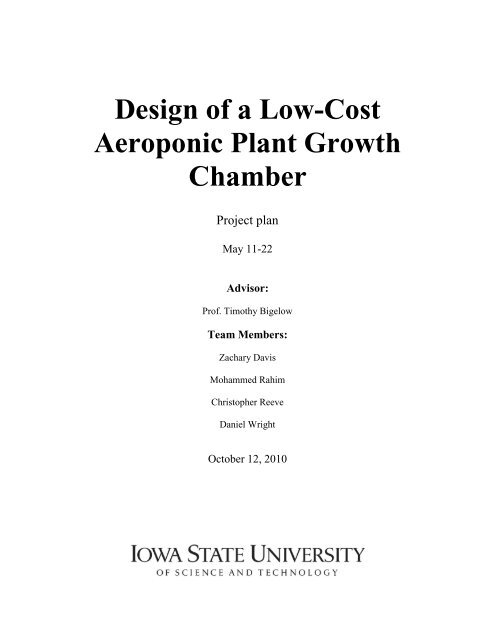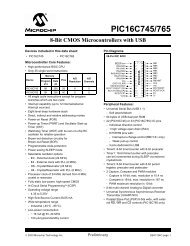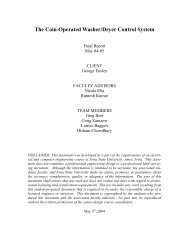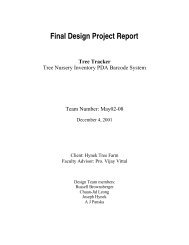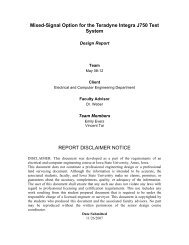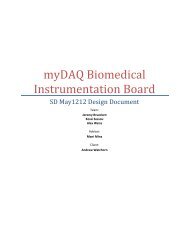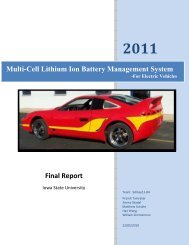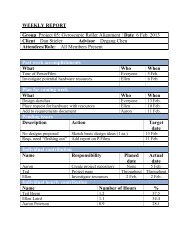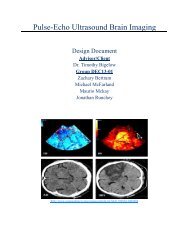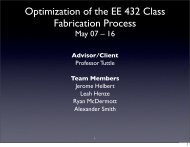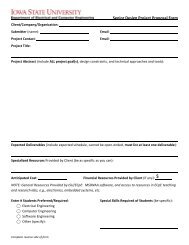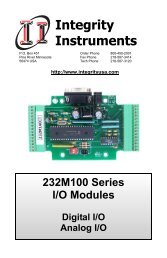Design of a Low-Cost Aeroponic Plant Growth Chamber
Design of a Low-Cost Aeroponic Plant Growth Chamber
Design of a Low-Cost Aeroponic Plant Growth Chamber
You also want an ePaper? Increase the reach of your titles
YUMPU automatically turns print PDFs into web optimized ePapers that Google loves.
<strong>Design</strong> <strong>of</strong> a <strong>Low</strong>-<strong>Cost</strong><br />
<strong>Aeroponic</strong> <strong>Plant</strong> <strong>Growth</strong><br />
<strong>Chamber</strong><br />
Project plan<br />
May 11-22<br />
Advisor:<br />
Pr<strong>of</strong>. Timothy Bigelow<br />
Team Members:<br />
Zachary Davis<br />
Mohammed Rahim<br />
Christopher Reeve<br />
Daniel Wright<br />
October 12, 2010
Table <strong>of</strong> Contents<br />
Executive Summary ........................................................................................................................ 3<br />
Problem Statement .......................................................................................................................... 4<br />
System Block Diagram ................................................................................................................... 4<br />
System Description ......................................................................................................................... 4<br />
<strong>Chamber</strong> Environment ................................................................................................................ 5<br />
Control Environment .................................................................................................................. 5<br />
Sensor & Control Hardware........................................................................................................ 5<br />
Operating Environment ................................................................................................................... 6<br />
Operating Parameters .................................................................................................................. 6<br />
User Interface Description .............................................................................................................. 6<br />
Functional Requirements ................................................................................................................ 6<br />
Non-Functional Requirements ........................................................................................................ 7<br />
Market Survey ................................................................................................................................. 7<br />
End Product & Major Deliverables................................................................................................. 7<br />
Work Plan ....................................................................................................................................... 8<br />
Work Breakdown ........................................................................................................................ 8<br />
<strong>Cost</strong> ............................................................................................................................................. 8<br />
Schedule ...................................................................................................................................... 9<br />
Risks ............................................................................................................................................ 9<br />
References ..................................................................................................................................... 10<br />
Contact .......................................................................................................................................... 10<br />
2
Executive Summary<br />
As humans, our lives necessitate the need for food. This food comes from many sources, one <strong>of</strong><br />
them being plants. Since this is important to our very survival, there is a need for research to<br />
produce disease resistant and quicker producing plants. In order to conduct research there needs<br />
to be a controlled environment, which allows a researcher to change different variables in the<br />
growth <strong>of</strong> a plant to see what effects it has. Many <strong>of</strong> these controlled environments employ the<br />
use <strong>of</strong> aeroponics (where the roots <strong>of</strong> the plant are in air instead <strong>of</strong> soil or water) to grow the<br />
plants. The use <strong>of</strong> aeroponics is also undergoing research as a way to grow plants easier in<br />
space. Since aeroponics uses less water than either hydroponics or geoponics this could be<br />
beneficial on extended excursions.<br />
Our goal at the end <strong>of</strong> our senior design project is to have a low cost controlled plant growth<br />
chamber that utilizes aeroponics. <strong>Growth</strong> chambers that are currently on the market can cost<br />
nearly $100,000, so a cheaper alternative could greatly enhance research that is being performed.<br />
In order for our chamber to be a serious competitor, we need to have the same types <strong>of</strong> sensors<br />
<strong>of</strong>fered by the current solution. This means that our chamber will need temperature, humidity,<br />
CO2, and atmospheric pressure sensors. We also must be able to keep a consistent temperature,<br />
provide nutrients to the plants, have a consistent airflow, and be able to give the plants light.<br />
There is also a desire to see what effects sound has on the growth <strong>of</strong> the plants. Therefore, our<br />
chambers will have speakers in order to try different frequencies on the plants. Beyond this, we<br />
would like to have the ability to control the settings for multiple chambers from one central<br />
location.<br />
3
Problem Statement<br />
Many disciplines do research with plants and need a controlled growth environment. Existing<br />
growth chamber solutions available are far too expensive for typical use in research. Our team‟s<br />
task is to design and build an economically feasible controlled environment for the growing and<br />
monitoring <strong>of</strong> plants using aeroponics. Such a system has many applications in research and<br />
other fields.<br />
System Block Diagram<br />
System Description<br />
The system has three major components. The first is the chamber environment. This is the<br />
physical environment, such as temperature and humidity, which we need to monitor and control.<br />
The second part is the control block. This part is responsible for monitoring and affecting the<br />
chamber environment through sensors and heaters, etc. This consists <strong>of</strong> a microcontroller and<br />
the application s<strong>of</strong>tware, not the sensors themselves. The third part <strong>of</strong> the system is the physical<br />
sensors and other environment modifiers such as heaters, water pumps and lights. This part <strong>of</strong><br />
the system provides feedback to the control system on the chamber environment.<br />
4
<strong>Chamber</strong> Environment<br />
The physical attributes <strong>of</strong> the growing chamber, hereafter referred to as „the chamber‟, is where<br />
the plants grow. There are a number <strong>of</strong> factors that must be carefully monitored and some that<br />
must be controlled. According to the International Committee for Controlled Environments, the<br />
minimum measuring and reporting guidelines are:<br />
Radiation<br />
Temperature<br />
Atmospheric Moisture<br />
Carbon Dioxide<br />
Air Velocity<br />
Watering<br />
pH<br />
Electrical Conductivity<br />
Substrate<br />
Nutrition<br />
<strong>Chamber</strong> dimensions<br />
For our project, it will not be necessary to monitor or report substrate, as aeroponic growing uses<br />
no substrate. Of the remaining parameters, only the Temperature, Radiation, and Air Velocity<br />
will be actively changeable with our setup; the rest will simply need to be monitored and<br />
reported.<br />
The chamber itself will consist <strong>of</strong> a housing large enough for the plants to remain suspended<br />
through their growth cycle, as well as all the hardware required to vent, water, light, heat/cool,<br />
and drain the plants growing inside.<br />
Control Environment<br />
The control environment for the system will consist <strong>of</strong> a microcontroller interfaced to the various<br />
sensors that will be responsible for reporting the current conditions and activating the active<br />
elements (heater, pump, light, etc.). The microcontroller will be able to remotely communicate<br />
with a separate computer that will serve as a database and web server. With the computer, lab<br />
technicians will be able to monitor the current state and activate or schedule active element<br />
events. This system consists <strong>of</strong> both hardware and s<strong>of</strong>tware elements.<br />
Sensor & Control Hardware<br />
A wide array <strong>of</strong> sensors is needed to properly monitor all the required parameters. In addition,<br />
the chamber must provide a way to heat, vent, light, and water the plants inside. The sensors<br />
must be accurate and able to withstand the humid environment <strong>of</strong> the chamber. The light, water<br />
pump, and ventilation fans must be easily controllable with a microcontroller. Each sensor is a<br />
discreet component, and is connected to the control system by wires.<br />
5
Operating Environment<br />
The operating environment for our project will consist <strong>of</strong> the physical environment that the<br />
growth chamber is placed in. It does not consist <strong>of</strong> the environment inside the growth chamber,<br />
thought it may effect it. The growth chamber gets its air from the outside environment, so<br />
conditions such as temperature and humidity do affect it to some degree.<br />
Operating Parameters<br />
The growth chamber is designed to be placed in a relatively stable lab setting. The chamber does<br />
have some facilities to change its internal temperature and humidity, but these are not effective<br />
outside a certain range. This range is determined by the insulation factor <strong>of</strong> the chamber walls,<br />
but in general should be limited to between 50 and 90 degrees Fahrenheit. There are many<br />
reasons for this limitation, the most important <strong>of</strong> which is that the plumbing and mineral water<br />
tank are not insulated. Freezing temperatures would render the irrigation system inoperable, and<br />
possibly damaged. The exterior <strong>of</strong> the chamber is not water pro<strong>of</strong>, so it should not be placed in a<br />
location that is very moist or where there is a possibility <strong>of</strong> rain.<br />
Some plant growth chambers on the market today are <strong>of</strong> a chamber-in-a-chamber design. Our<br />
chamber does not have this requirement, it is self sufficient as long as the operating environment<br />
is kept to the reasonable levels stated above.<br />
The aeroponics growth chamber requires a stable, moderate, and dry environment in which to<br />
grow plants. The environment is free to fluctuate in a normal fashion, within the operating<br />
parameters, and the chamber will be able to maintain a reasonable environment for growing<br />
plants.<br />
User Interface Description<br />
The server will host an ASP.NET website to enable remote control <strong>of</strong> any number <strong>of</strong> growth<br />
chambers connected to the server. A user will be able to control many settings including, but not<br />
limited to, temperature control, lighting on/<strong>of</strong>f timing, speakers on/<strong>of</strong>f timing, and possibly the<br />
frequency <strong>of</strong> which the nutrient solution is sprayed. There will also be many aspects <strong>of</strong> the<br />
chamber that will be monitored, stored, tracked, and made available for viewing. This would<br />
include, but is also not limited to, the monitoring <strong>of</strong> the temperature, humidity level, timing <strong>of</strong><br />
the pump (nutrient spray), CO2 & O2 concentration, and when the speakers are on. These things<br />
will be periodically stored in a SQL database. The website will be secure, requiring a user name<br />
and password to enter. Only accounts given administrator privileges will be allowed to change<br />
any growth chamber settings.<br />
Functional Requirements<br />
1) To build a fully-functional, low-cost aeroponics growth chamber<br />
2) To keep the roots <strong>of</strong> the plants in the dark, as required for aeroponics growth chambers<br />
6
3) To prepare the correct Hoagland solution (Type I) to provide nutrients to the plant in an<br />
aeroponics setting<br />
4) To have the capability to administer sound (audible and ultrasound) to the plants inside the<br />
growth chamber to investigate its effects (if any)<br />
5) To have the capability to control and monitor various environmental parameters from a<br />
remote server. The parameters that need to be controlled are:<br />
a) Radiation (Light)<br />
b) Temperature<br />
c) Carbon Dioxide (CO2)<br />
d) Air velocity<br />
e) Watering<br />
f) Sound<br />
Non-Functional Requirements<br />
1) To monitor, measure, and report the following parameters as required by North Central<br />
Extension & Research Activity–101 (NCERA-101):<br />
a) Atmospheric pressure inside the chamber (Water vapor pressure deficit (VPD) or Relative<br />
Humidity (RH))<br />
b) pH and Electrical Conductivity (EC) <strong>of</strong> the nutrient solution<br />
c) Substrate (this will be air for our aeroponic growth chamber)<br />
d) Nutrition (Hoagland solution Type I)<br />
e) <strong>Chamber</strong> properties:<br />
i) Specifications (floor area)<br />
ii) Barrier beneath lamps (whether present and its composition)<br />
iii) Air flow (whether up, down or horizontal)<br />
2) To build a visually-appealing web interface to monitor and control various physical<br />
parameters (as indicated above) inside the growth chamber.<br />
Market Survey<br />
In order to get a better understanding <strong>of</strong> aeroponics and plant growth chamber our group had a<br />
meeting with Dr. Richard Gladon from the Department <strong>of</strong> Horticulture here at Iowa State<br />
University. He informed us <strong>of</strong> what parameters needed to be monitored in order to have research<br />
be considered valid. This is what determined the types <strong>of</strong> sensors that we will need and how we<br />
will need to report things to the user. He also suggested that we design a growth chamber that<br />
can accommodate tomatoes. These are the simplest to grow and are common for an initial study.<br />
End Product & Major Deliverables<br />
At the end <strong>of</strong> our project we expect to have these documents up to date and delivered:<br />
Project Plan<br />
<strong>Design</strong> Document<br />
7
Final Report<br />
Project Poster<br />
For the end project we will have two aeroponics chambers. These chambers will be able to keep<br />
a consistent temperature, CO2 level, humidity level, and atmospheric pressure. There will also<br />
be the ability to have an audible tone played and a light turned on and <strong>of</strong>f. All <strong>of</strong> these can then<br />
be user defined. The user will be able to log onto a web server in order to change the settings <strong>of</strong><br />
any given chamber. The specific chamber will then have its status changed via a Bluetooth link<br />
to the web server.<br />
Work Plan<br />
Work Breakdown<br />
This table explains the estimated amount <strong>of</strong> hours that will be spent, by each member, on the<br />
major portions for our project<br />
Project Plan <strong>Design</strong> Implement Test Total<br />
Chris Reeve 10 30 100 30 170<br />
Zachary Davis 10 30 100 30 170<br />
Mohammed<br />
Rahim<br />
10 30 100 30 170<br />
Daniel Wright 10 30 100 30 170<br />
<strong>Cost</strong><br />
Below is a table showing the cost breakdown<br />
Item <strong>Cost</strong><br />
Sensors ($40 x 2) $80.00<br />
Microcontroller ($20 x 2) $40.00<br />
Microcontroller Board ($50 x 2) $100.00<br />
<strong>Chamber</strong> Parts ($50 x 2) $100.00<br />
Chemicals $50.00<br />
Web Server $50.00<br />
Total $420.00<br />
Labor ($20/hour) $13,600.00<br />
Fictional <strong>Cost</strong> $14,020.00<br />
8
Real <strong>Cost</strong> $420.00<br />
Schedule<br />
Risks<br />
1. Some <strong>of</strong> the existing components do not work<br />
Problem: If some <strong>of</strong> the components that are already around do not work then we will<br />
need to buy more than we expected. Since we only have a limited budget this could<br />
cause us to go over budget.<br />
Resolution: If there is still money left then we can probably simply buy the needed parts,<br />
if not then we will need to find money elsewhere. When first buying things we need to<br />
leave money for a problem like this.<br />
2. Exceeding the project budget<br />
Problem: There are many things that we would like to include, but only have a limited<br />
budget to do it on. This means that we might not be able to afford everything that we<br />
want.<br />
Resolution: We would need to reconsider some <strong>of</strong> our desires. One would be instead <strong>of</strong><br />
having a wireless link from the chambers to the web server we might have to have a<br />
wired one. Also, we might be able to only do one chamber instead <strong>of</strong> two.<br />
9
References<br />
Langhans,Roberts and Tibbitts,Theodore, eds. “<strong>Plant</strong> <strong>Growth</strong> <strong>Chamber</strong> Handbook.” Ames: Iowa<br />
State University, 1997.<br />
Contact<br />
Advisor<br />
Timothy Bigelow<br />
2113 Coover Hall<br />
Ames, IA 50011<br />
Phone: 515-294-4177<br />
Email: bigelow@iastate.edu<br />
Students<br />
Zachary Davis<br />
4700 Mortensen Rd<br />
Ames IA, 50014<br />
Phone: 641-233-7209<br />
Email: zdavkeos@iastate.edu<br />
Mohammed Rahim<br />
140 University Vlg Apt F<br />
Ames, IA 50010<br />
Phone: 515-572-4719<br />
Email: mrahim07@iastate.edu<br />
Christopher Reeve<br />
530 Welch Ave Apt 1<br />
Ames, IA 50014<br />
Phone: 641-203-2429<br />
Email: creeve@iastate.edu<br />
Daniel Wright<br />
2511 Bristol Drive #201<br />
Ames, IA 50010<br />
Phone: 515-401-2429<br />
Email: dwwright@iastate.edu<br />
10


